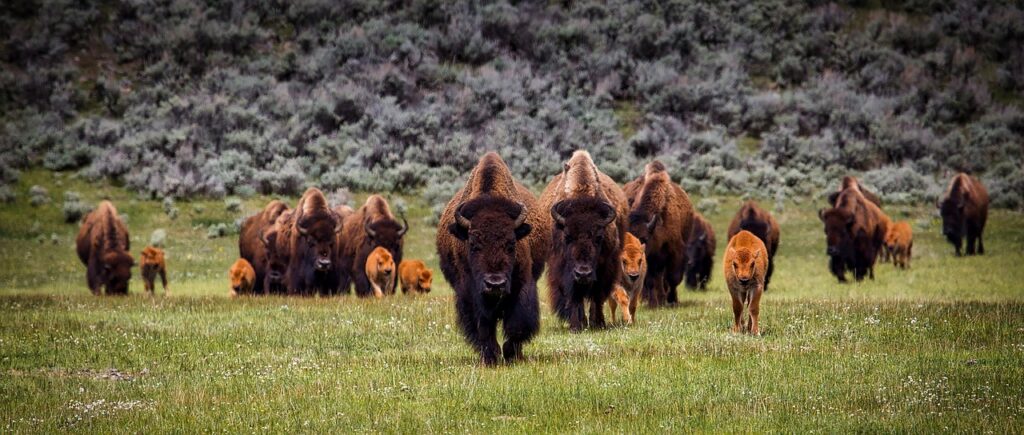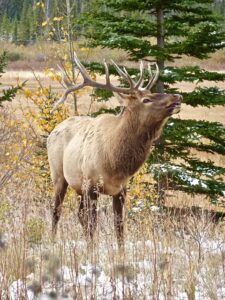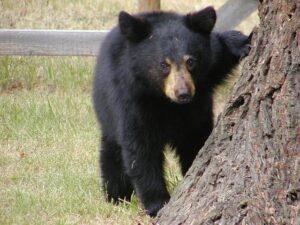When Bison (and other wildlife) Attack: The Question of Animal Etiquette

The news media have reported a surprising number of stories this summer concerning bison attacking people in national parks, though if the animals could speak our language for a few minutes they might contend that they were not so much attacking humans as defending against them. People sometimes treat wild animals as if they were stage props for photographs, or children wanting to be cuddled and played with, rather than mature animals with their own expectations about proper decorum between species.
Bison are among the most dangerous animals visitors are likely to encounter in parks and wildlife refuges—they do more than grizzly bears ever will to educate tourists about the risks of getting too close to wildlife. Most park visitors probably know to stay away from bears and such. Bison and other hoofed species are likely another matter. Bison, moose, and elk are relatively easy to get near and seem docile. Here is advice from experts on proper etiquette around bison and other hoofed giants, as found in my book Return of the Bison: A Story f Survival, Restoration, and a Wilder World:.
The National Park Service says we should stay 100 yards (the length of a football field) from wolves and bears and 25 yards from bison (to which I would add elk and moose) especially during mating season. When near large species like bison, monitor their activities. During the spring mating season, roughly from June to September, bulls are especially irate. If a bull in your vicinity is pawing up dust, bawling, and shaking his head, move with caution. In the bison’s world, creatures that approach it or make sudden moves are likely to be predators, so a person who approaches or runs may trigger an attack. Cows with calves are particularly defensive. If you find yourself among peacefully grazing bison and notice that one or more stop eating and begin watching you, recognize that they may be alarmed and are assessing you as a possible threat. With bison, watch the tail. A raised or partially raised tail may be a sign of agitation. A moose or elk that gives you a stare and shakes its head is delivering a warning and urging you to back off.
Be wary of stumbling upon a buffalo—or moose or elk—that has been hidden around the next bend in the trail or by shrubs. These animals can switch from placid to aggressive very quickly, especially if startled, though generally they want to avoid conflict as much as we do.
If you do meet bison on a trail, turn around and retreat or go far around them, if conditions allow. Don’t stand your ground in a show of bravado. In a battle of wills, you cannot dominate a bison, unless perhaps you weigh around 2,000 pounds and have horns.
If you want to observe bison and other wildlife close up, do so from a motor vehicle or through binoculars. Keep in mind that a buffalo may ram a motor vehicle and cause extensive damage with a single blow. So even in a vehicle watch for warnings of irritation.
Strange Wildlife Confrontations I Have Seen
Reading the recent reports of bison attacks has brought to my mind a couple incidents when I witnessed the violation of a wild animal’s sense of etiquette. Either of these little dramas could have ended in tragedy. Neither would have been possible if park visitors had exerted a modicum of common sense with wild animals.
The more bizarre confrontation occurred in Yellowstone National Park and was an extreme example of how utterly bonkers people can be around wildlife. I pulled into a small parking lot and scanned a wide sweep of prairie punctuated with scattered trees. I instantly froze in shock for a moment or two before jittering out of my car and standing beside it, wondering what to do. There, about 50 yards out, was a bull elk with a rack of long-tined antlers meant for fending off the assaults of other, 900-pound bull elk during mating season. Big as a quarter horse, the elk had its head down and was rattling its sabers—the sharp-pointed antlers—at a man, probably in his twenties but not likely to see his thirties, who was standing perhaps 10 feet from the elk face to face, laughing it up and aping for a video camera in the hands of another young man about 30 feet to the side. I couldn’t hear what the two were saying, but the elk’s lowered head sent a clear message even across 50 yards.

The two men weren’t getting it. The one in front of the elk happily gesticulated and capered around while the video rolled. I thought, This is it, I’m going to see this man gored to death, he’s going to die. But he didn’t. Instead, he shrugged off his escapade and joined his friend, heading to the parking area. I started breathing again. The elk stood staring off into space, perhaps feeling he had stared down a grave danger. But such episodes as this one are the substance of dangerous human/wildlife encounters. This blockhead apparently couldn’t grasp that the elk was giving a final warning. Fate must have been out to lunch that day, because it was certainly being tempted but let the potential for mayhem go by.
The other incident also occurred a number of years ago. A photographer and I were following a young black bear—maybe a third its adult body weight, though I have nothing in the way of expertise for calculating such a thing. Anyway, it was maybe the size of a golden retriever. We wanted a bear photo for a book we were working on, so we quietly trailed the little black bear, keeping a socially considerate distance from the bear as it went up a hillside and among sparse trees. There it stopped, lay on the ground, and went casually to sleep, as if it had nary a worry in the world and no concerns about the human duo hanging around. But . . . someone had spotted us. A tall, middle-aged woman arrived and chatted with us about the bear, then sat down right next to it so her husband, who had caught up with her moments before, could take a picture of her with the little bruin. The bear, as the woman took a position beside it and smiled at the camera, woke up, looked at the woman, and lunged toward her with its jaws chomping the air without biting her.
“Look,” she said, “he likes me.”
He’d like to take your arm off, I thought.

I suggested she might want to move along. And, her photo now on film, she went cheerfully on her way, never recognizing her danger, as people involved in such incidents seem rarely to do.
Some General Rules of Wildlife Etiquette
Which brings us back to people being attacked by bison in national parks. Aside from the specifics for safe behavior recommended by the National Park Service, I want to add a few general suggestions for keeping interactions with wildlife cool and calm.
When near a wild animal, look for signs of anxiety or aggression in the animal. I would bet that fear, not hostility, is the impetus for most confrontations between wildlife and people. Ergo, keep track of what you are doing, what signals you may be sending to the animal that it might interpret as a threat. Don’t crowd it. Don’t stare at it for a prolonged period. A direct stare serves as a sign of aggression in many mammals. Treat wildlife as if they are adult animals that expect to be left alone. If they are with offspring, be warier still.
Bears, mountain lions, and wolves rarely bother people, but of course attacks do occur. After all, these animals hunt deer and other large hoofed animals (though even wolves seem to avoid preying upon healthy bison unless very hungry) and are fully equipped for harming humans. Children are more vulnerable than adults. Even the spaniel-sized coyote kills the fawns of deer and pronghorn, so it’s not surprising that a small human child, in the eyes of one of these predators, might evoke the image of a fawn. But even adult humans have run into trouble with, for example, mountain lions, generally when jogging or biking alone in lion habitat. What, to a predator, says fleeing prey species better than a person running alone? So we have to be smarter than these species, which, fortunately, is not much of a challenge: when in areas with larger predators, stay in groups of three or more, make noise when hiking the woods, and don’t let children roam around alone. But keep in mind that attacks on humans are extremely rare. A park with two million visitors a year may report half a dozen encounters with irate bison.
For more information, try these three informative sites:
https://wildlife.utah.gov/news/utah-wildlife-news/1223-stay-safe-around-bison.html